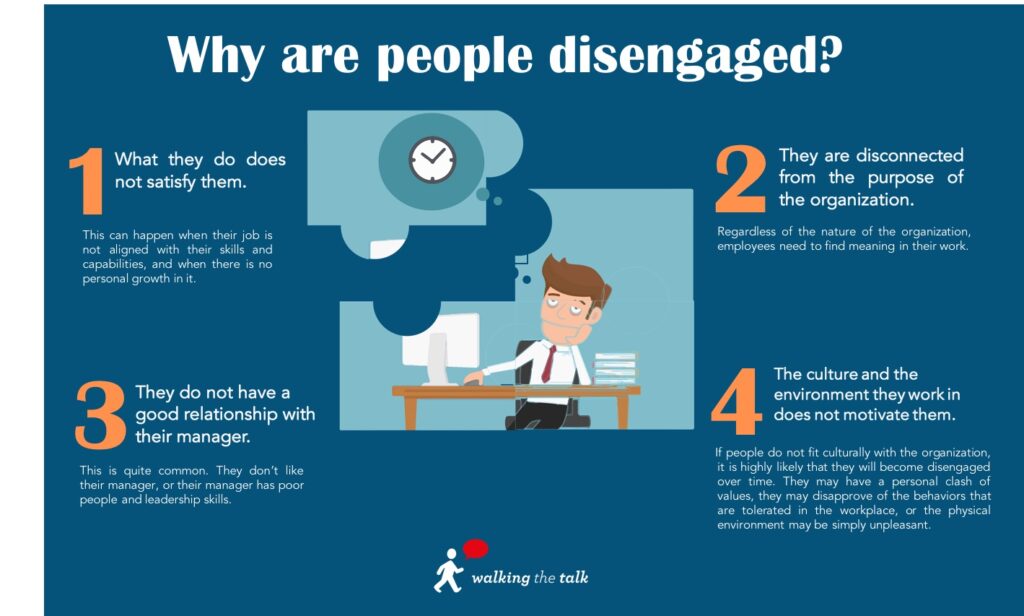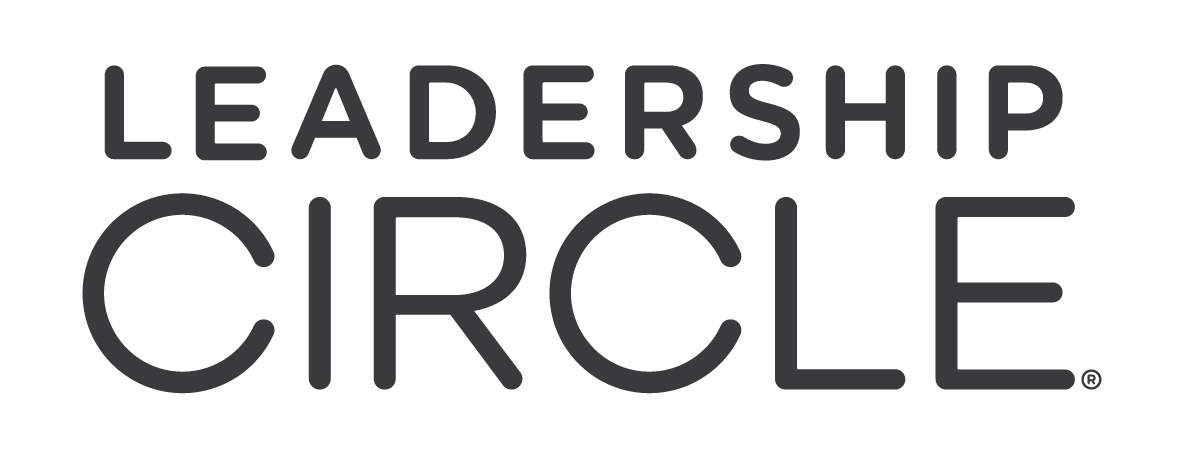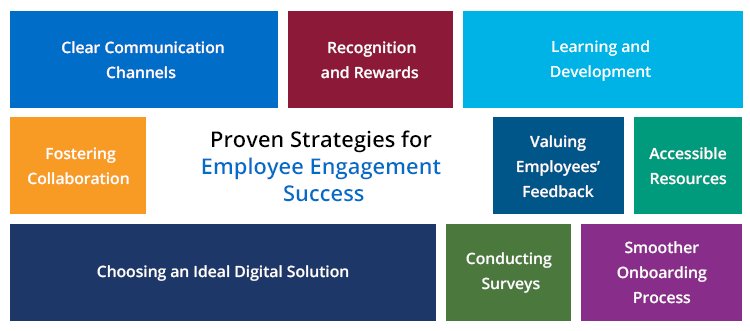Disengaged employees are more than just a drain on motivation in the workplace—they’re a direct line to the gaps that exist in leadership and organizational processes. U.S. companies lose over $500 billion annually due to disengagement, and it’s no surprise why. From reduced productivity and high turnover to a deeply impacted workplace culture, disengagement costs ripple throughout entire organizations.
But disengagement isn’t about laziness or a lack of care. At its core, it’s a signal. And for leadership, it’s an opportunity to recalibrate. This blog will uncover how employee disengagement stems from leadership misalignment and power imbalances and offer a roadmap to reignite engagement.
 Image Source: iHire
Image Source: iHire
Spotting the Early Signs of Disengagement
Disengagement rarely happens overnight. It creeps in slowly, revealing itself in ways that sometimes go overlooked. Leaders need to tune into these indicators to take preemptive action.
5 Common Signs of Disengaged Employees:
- Withdrawal from Collaboration: Employees may avoid teams, skip brainstorming sessions, or disengage during meetings.
- Reduced Initiative: An employee who previously took ownership of tasks may now default to only what’s assigned to them.
- Avoidance Behavior: Noticeable attempts to avoid direct contact with management or peers, such as frequent excuses to skip one-on-one meetings or provide minimal updates.
- Change in Quality or Timeliness of Work: Declining productivity, missed deadlines, or completing only the bare minimum could indicate a lack of involvement.
- Emotionally Flat Responses: Disengagement often hides in subtle cues like lackluster tone during conversations or emotional detachment from goals or results.
Pro tip: Want sky-high engagement? Give every employee a chance to do what they do best every day—it’s the #1 predictor of thriving teams according to Gallup.
Understanding the Root Causes of Workplace Disengagement
Many organizations attempt to bandage disengagement with quick fixes like surveys, team events, or incentives. While these can uplift spirits momentarily, they do little to tackle the structural roots causing employees to check out.
Surface Symptoms vs. Root Causes
- No Purpose: Engagement thrives when work feels meaningful. Employees are often disengaged when they don’t understand how their roles align with the organization’s greater mission.
- Absence of Psychological Safety: Without trust or a safe space to share ideas, employees will avoid risk and disengage from challenging but fulfilling opportunities.
- Leadership Mistrust: Feeling disconnected or unsupported by management is one of the leading drivers of disengagement. Leaders who are overly controlling or distant inadvertently isolate their employees.
- Lack of Growth Opportunities: An unchanging or lackluster career trajectory contributes significantly to restlessness. Employees want to feel they’re growing—not stuck.

Why Leadership Behavior Matters Most
According to the Leadership Circle Profile, disengagement often mirrors leadership behavior itself. When leaders operate out of a Reactive mindset (controlling tendencies or defensive management), those behaviors ripple into teams. On the other hand, Creative leadership prioritizes trust, alignment, and purposeful vision, inspiring employees to take ownership of their roles.
How Leadership Self-Awareness Reignites Engagement
Shifting workplace engagement starts with a hard look in the mirror for leaders. Your presence and decision-making set the tone for how seen, valued, and supported employees feel.
Start with Self-Reflection
Leadership patterns can unintentionally exacerbate disengagement. Reflect on whether aspects of your management style might discourage initiative or collaboration. Are you micromanaging? Failing to inspire trust? Lacking clear communication? These are opportunities for growth.
Tool for Leadership Insight
The Leadership Circle Profile 360° Assessment (LCP) offers deep insights into leadership patterns and their impact on team performance by evaluating core behaviors and underlying beliefs.
Strategies to Rebuild Engagement and Trust
Once leaders have started aligning their behaviors with Creative competencies, systemic engagement strategies follow naturally.
Practical Steps to Re-Engage Employees
- Create Honest Feedback Loops: Build consistent channels where employees can share their thoughts confidentially, such as pulse surveys or one-on-ones. Show genuine action in response to feedback.
- Reconnect Teams to Shared Purpose: Create discussions that bridge employee roles to the company’s core mission. Explain why their work matters.
- Recognize and Celebrate Milestones:Regularly acknowledge both individual achievements and collective milestones to foster a personal connection to success.
- Empower Middle Managers:Middle managers directly impact culture. Equip them with training on Creative leadership approaches like Courageous Authenticity or Relating outlined in LCP’s framework.
- Encourage Autonomy and Growth:Allow employees to take ownership of projects without over-the-shoulder oversight, and offer reskilling opportunities to expand career pathways within the company.
Image Source: Biz Portals 365
Leadership Beyond Compliance
True engagement demands moving beyond avoiding burnout. It calls for cultivating buy-in at an emotional and aspirational level.
What Sets Great Leaders Apart
Creative leadership shifts disengagement into alignment. Competencies such as Purposeful Vision and Balance from the Leadership Circle enable leaders to meet challenges with innovation, encouraging employees to mirror that energy.
Creative Mindset Examples in Action
- Leaders who lean into Relating create stronger camaraderie with employees, making them feel valued as people and contributors.
- Aligning toward Courageous Authenticity inspires employees to share bold ideas without fear, promoting creativity and improving team wins.
If you sense your organization is running on compliance rather than commitment, your leadership may be the unlock.
Employee Disengagement Is a Roadmap
Every instance of disengagement is data you can act on. It’s more than a performance issue; it’s an invitation to reimagine how leadership aligns with values. When you build trust, foster meaningful purpose, and highlight employees’ potential—all while staying reflective as a leader—you don’t just reignite engagement. You transform your workplace culture.
Your next step could change everything. Schedule a leadership consult with us today and explore strategies to bring your team’s creative potential to the forefront.







It’s interesting to think of disengagement as a signal rather than a simple issue to solve. Leaders often focus on trying to fix the symptoms without addressing the root cause, which is often an underlying misalignment in leadership or systems.
This content deserves all the appreciation and recognition it can possibly receive today
Grateful for the positivity you spread here. Truly appreciated!
This content highlights the beautiful aspects of human connection and community spirit
I like the efforts you have put in this, regards for all the great content.
This disengagement analysis hits the mark! Your “quiet quitting” versus active disengagement distinction is crucial. That manager trust breakdown statistic is alarming yet unsurprising. The three leadership reset strategies are practical and actionable. Your inclusion of stay interview questions helps prevent turnover proactively!